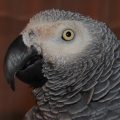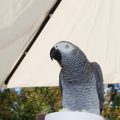Table of Contents
Do you happen to suddenly want to pet an African Grey or are you already an African Grey owner? Do you happen to have a hard time in knowing the right way; or doubt yourself that you are not taking care of them very well, or you are not doing enough? Well, get those worries away for I will show you how to take care of your pet African Grey the right way with comprehensive reasoning to do so. Just as with any pet; an African Grey is not an exemption to not prioritize their well-being, taking care of them should be your utmost responsibility because you choose to have them in the first place. In addition to that, petting an African Grey is fun and the connection you can have with them can be an amazing, fulfilling; and extremely rewarding experience.
Shelter
Their shelter should be an appropriate cage; specifically made for African Greys so we can assure that they are comfortable at all times. Opt for square or rectangular cages because African Greys tend to feel uneasy, unsafe in those rounded cages. The size should be in consideration of your African Grey’s size, it should have enough room for toys, perches, feeding equipment; and areas where they can rest with ease.
Their shelter should be placed in a room where interactions take place. African Greys are social creatures and require constant contact, if not; they can develop separation anxiety and isolation may cause them distress. African Greys like to be surrounded by other people hanging out and socializing.
Lastly, their shelter should have a steady temperature. While African Greys can tolerate a large range of temperatures, it is important that you give them their ideal temperature. African Greys’ ideal temperatures are between 65-85 degrees Fahrenheit. African Greys should not be left in a chilly room; and they should not be placed when you are about to drop your thermostat overnight during winter. Remember, temperatures that are below 40 degrees are already considered to be dangerous for them.
Food
Your African Grey’s diet should have variety in them. In best cases; African Greys need not be placed just in a diet of seeds and pellets only, however, these two are a great base on their diet, it is not enough. Try incorporating fruits and vegetables because African Greys love them, and they are highly nutritious for them. For starters, go for bananas, grapes, apples, and for greens, go for cooked peas, green beans, and squash. Just do not overdo feeding them fruits because of their sugar content.
As to the foods that are bad for them; please do not feed them caffeine, alcohol, greasy foods, chocolate, dill, cabbage, eggplant, rhubarb leaves, asparagus; and raw or dry beans. Avocados and onions are toxic ones that should not be near them, it can cause immediate cardiac arrest and death in our African Greys.
Do not cook your African Grey’s food in a non-stick pan, and utensils. The chemicals found in non-stick pans can be deadly and toxic to African Greys as well.
As to the process of feeding itself, Small African Greys should have food; and water containers of at least 20 ounces; feed them appropriately and correctly. Large African Greys should have food and water containers of at least 30 ounces. Their water containers should be large enough for them to bathe in; because African Greys bathe in their own drinking water, and it works fine for them.
Daily/ Occasional things to do in keeping your African Greys at their best health state
Clean their food and water containers every day. Regularly remove the food and water residue, clean them and replace them with fresh foods and water afterward. Do not let those foods rot because we do not want to give them bacteria; since they are also prone to acquiring them.
Spot clean their cages every day, especially those that take the least amount of them. As for the bottom of their cages, it can take two days for you to wait and clean them. Their cages themselves can be cleaned once a week; with bird-safe disinfectant since human disinfectants are too strong, thus might cause harm for our African Greys.
Visit the vet on a regular basis, some do annual, some semiannual, quarterly, some are okay with monthly. African Greys are generally healthy; and this state can last to their lifetimes but there are instances when vet consultations can really give immediate relief and preventive measures; if your African Grey has been experiencing troubles you might be overlooking.
If they are losing their appetite, or experiencing weight loss; are having a hard time breathing; have swollen eyes and or eyelids; if they have stains around their eyes or nostrils; or if they are being overly quiet, you should take them immediately to the vet instead of waiting for them to be better; this is probably a symptom of an underlying health problem. Hence, it is better to get them checked as soon as possible.
Keep In Mind
To take care of your African Grey’s well-being as well; take time to socialize and play with your African Grey on a regular basis. Educate yourself as to what is the best approach if you want to play with them; treat them with snacks that are friendly for them, tame your African Grey; talk to your African Grey and make sure that you approach them openly so they get to feel comfortable with you and safe as well.
To sum up, this information above is a great foundation to jump-start your petting journey with African Greys. Do remember that it is your sole responsibility to a pet in a way that is healthy, right; and not at all harmful. African Greys just as with us humans have the life that is meant to be lived as enjoyable; and as harm-free as possible.






 Author and long-time animal lover. Sharing knowledge on pet care through experience and the written word.
Author and long-time animal lover. Sharing knowledge on pet care through experience and the written word.